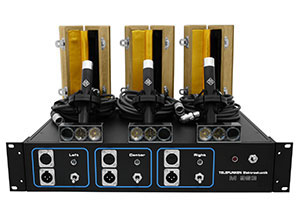TELEFUNKEN Announces ELA M 260 TRI-MONO System
TELEFUNKEN Elektroakustik (South Windsor, CT) has announced the new ELA M 260 TRI-MONO System, comprised of three matched ELA M 260 small diaphragm tube microphones, a custom M 963 TRI-MONO three-channel power supply, and adaptor spheres to emulate the omni effect of the original “Decca Tree” configuration introduced in the 1950s.

TELEFUNKEN's new ELA M 260 TRI-MONO System, shown with three small diaphragm tube mics, interchangeable capsules, triple power supply, and custom accessories.
The system will be on display throughout AES 2011 in NYC.
According to TELEFUNKEN, the TRI-MONO configuration was created to emulate the original design of Decca Trees, which employed three matched Neumann omnidirectional M50s, and accommodated small, medium, and large recording spaces.
The TRI-MONO set of ELA M 260 small diaphragm tube microphones features three interchangeable capsules for each mic (cardioid, hyper-cardioid and omni). The addition of both 30mm and 50mm adapter spheres allows the ELA M 260 omni capsule to be adapted to a spherical omni design emulating the prized effect achieved by the capsules found in original Decca Tree Neumann M50 microphones.
A custom M 963 TRI-MONO 2U rack space power supply has been designed to power all three microphones at one time. The TRI-MONO system also includes three 25′ right angle tube mic cables, elastic shock mounts and wooden microphone boxes.
TELEFUNKEN’s TRI-MONO system is intended to present an affordable modern equivalent of the method of recording with a strictly spaced mic array, commonly used for orchestral recording.
TELEFUNKEN notes that the technique was developed in the early 1950s and first commercially used in 1954 by the recording team at Decca Records to provide a strong stereo image. The left and right mics are placed about 6 feet apart, and the third is placed 3 feet out and centered in front. To mix, the side mics are panned hard left and right, and the output of the middle mic is then sent to both left and right channels.
Before finalizing the design of the ELA M 260 TRI-MONO microphone system, TELEFUNKEN conducted extensive Beta tests at some of the nation’s top recording facilities, including Skywalker Ranch, Meyer Sound Laboratories, and at Bob Weir’s TRI Studios in Northern California.
Please note: When you buy products through links on this page, we may earn an affiliate commission.






